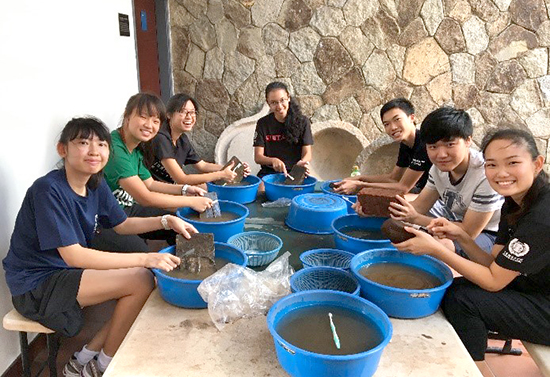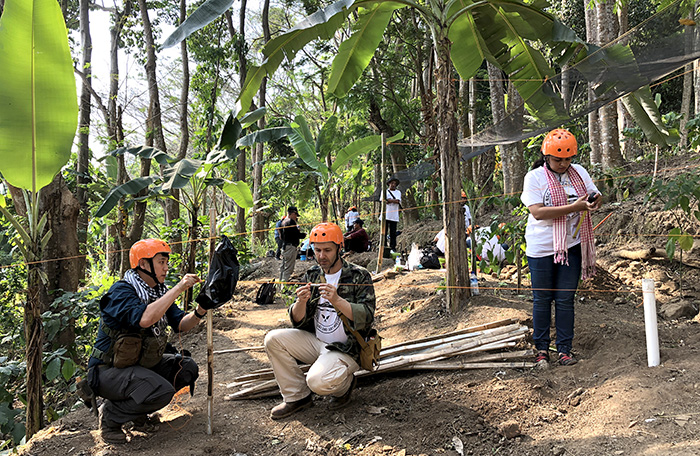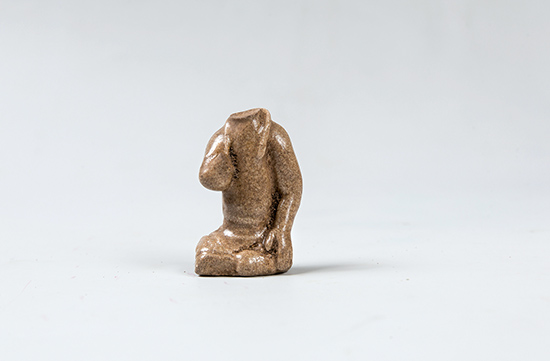For enquiries on the programme, please contact
Temasek History Research Centre
ISEAS – Yusof Ishak Institute
30 Heng Mui Keng Terrace
Singapore 119614
Tel: 6778 0955
Fax: 6775 6264
Email: thrc@iseas.edu.sg
Exciting publications to come. Please check back later.
Exciting events to come. Please check back later.
Exciting events to come. Please check back later.

Temasek Junior College students cleaning artefacts. (Credit: Lim Cheng Li)
Archaeology Programme for Students (APS) is a community engagement programme. ISEAS will host local students for one to four weeks, depending on their schedules. The APS will also include lectures and visits to museums and workshops for teachers which can be held in schools at their request.
During the attachment period, secondary school and junior college students will learn to handle 14th and 15th century artefacts found around our island state. This hands-on approach of washing, labelling, and analysing actual artefacts will deepen their observation, classification, and deduction skills, bringing history to life for Singaporean students. By handling artefacts from the past, they will be able to better imagine life on the island some 500 years ago.
Teachers’ Workshops will also be organised to impart basic archaeological skills and knowledge to teachers in order to enhance their history lessons for wider impact. The Teachers’ Workshops will equip teachers with archaeological facts and pedagogical information to enable them to translate this knowledge in their classrooms, thus achieving a self-sustaining programme.
Why is it important?
Archaeology helps to answer questions about who we are and where we come from. Singapore’s archaeological endeavours span over 30 years and much of the work has been conducted in the last decade. It is necessary for the results be disseminated to the public, especially to students. It allows the students to appreciate the past and understand that they are stakeholders in Singapore’s heritage.
How it is helpful for students?
Archaeology is a discipline for understanding the past but its practices are also useful in developing observations skills and critical thinking. For example; archaeology
- Allows practitioners to hone their observation, classification, deduction and analytical skills in relation to their environment.
- Allows a wide range of skills and knowledge to be applied to understand the past due to its multi-disciplinary nature.
- Requires a hands-on approach which helps with kinesthetic learning.
- Helps students generate questions, create hypotheses and reach conclusions based on inference and deduction.
Objectives of the APS
The APS has four main objectives:
- Nurture an understanding of archaeology as a discipline;
- Nurture an appreciation of archaeology and history in Singapore and Southeast Asia;
- Provide an introduction to the various processes in archaeology;
- Provide an opportunity to learn about other related topics regarding the past which can impact today’s society.
Those interested in the programme are welcomed to contact thrc@iseas.edu.sg.
 Michael Ng (left) teaching participants to produce scale maps and plans of the site. (Credit: Aaron Kao)
Michael Ng (left) teaching participants to produce scale maps and plans of the site. (Credit: Aaron Kao)
Southeast Asian Heritage Programme (SEAHP) will take the form of an annual archaeology and art history field school in a Southeast Asian country.
The objective of the Field School is to create local awareness among young Singaporeans of Southeast Asian history and its culture. Singaporean students will travel to conduct archaeological surveys and excavations, visit historically significant sites, and attend lectures by local experts. This will give our students first-hand experience of the history and heritage of ASEAN member countries and an opportunity to develop familiarity and appreciation for the cultures of our immediate neighbours.
The SEAHP will seek to first, impart basic archaeological skills and experience to young Singaporeans; and, second, to inculcate an understanding of the histories and civilisations of our ASEAN neighbours among young Singaporeans in order to better navigate contemporary politics and regional sensitivities.
The Field School will be two to three weeks long and will host six to ten undergraduate level students. Students from all disciplines are welcome to apply.

An artefact from the Empress Place excavation conducted in 2015.
Singapore and the Region Programme (SRP) will seek to bring intellectual leadership to the issue of national identity and heritage.
The SRP will host one to two Visiting Fellows per year. Under this Programme, historians, art historians, linguists, anthropologists, or archaeologists will conduct original research to examine Singapore’s historical maritime and trade networks within the region, as well as the island’s changing role in different periods of history, in order to help us better appreciate the ways in which the external environment has impacted our nation and its character. The findings from this Programme will be converted, where possible, into resource teaching material for local schools.
Objectives of Temasek History Research Centre
- To strengthen national identity by deepening our understanding of Singapore’s history and heritage through original research on Singapore’s role in the premodern period.
- To deepen young Singaporeans’ understanding and familiarity with ASEAN cultures and heritage through archaeology and art history Field Schools.
- To create public awareness and promote public education of the Centre’s work by engaging local schools, local media, and interested communities.
The Centre has three programmes to support these objectives:
- The Singapore and the Region Programme
- The Southeast Asian Heritage Programme
- The Archaeology Programme for Students

The Temasek History Research Centre (THRC) was established at the ISEAS – Yusof Ishak Institute in 2019. THRC will focus on Singapore’s premodern history, its economic and socio-cultural links to the region, as well as its historical role as a trading centre. The Centre will seek to pursue historical research from the 12th to the 19th century in order to deepen our understanding of Singapore’s history and identity, and linkages to the region.
Research Scope
The Centre is particularly interested in research from the 12th century to the decline of the Sriwijaya empire (13th century), when Temasek emerged; as well as the Majapahit empire (14th century) onwards. Research on Singapore’s historic relations with the Malacca Sultanate (14th to 15th century) and the later Johor Sultanate (15th to early 19th century) is also of great interest to the Centre.
Research themes may include, though not restricted to:
- Singapore’s premodern role as a maritime trading port or centre;
- The island’s premodern economy, culture, and society, and its links to the region;
- Understanding Temasek as a political and cultural entity; and
- Singapore’s premodern relationship and engagement with political entities in the immediate region.
THRC welcomes researchers from history, archaeology, anthropology, linguistics, and other relevant disciplines. Research at THRC may be supported and complemented by existing archaeological artefacts excavated from the island in recent years.



